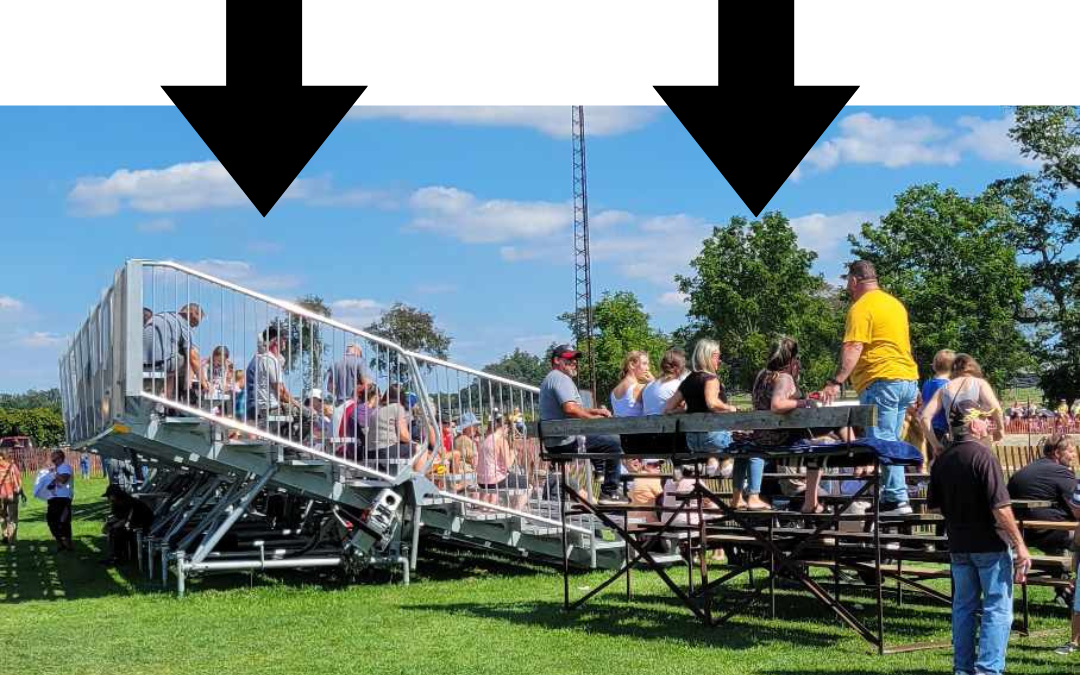Aluminum vs. Steel vs. Wood:
Which Bleacher Boards Are Best?
When it comes to bleacher seating, the type of seat and foot boards you choose makes all the difference—not just in appearance, but in safety, durability, and maintenance costs. The three most common materials are aluminum, steel, and wood. Here’s how they stack up against each other.
1. Safety and Comfort
- Milled Aluminum
One of the biggest advantages of milled aluminum is its textured, non-slip surface. Even when wet, it provides more traction than smooth steel or aging wood planks. That means fewer slips and falls for spectators. - Steel
Steel can be sturdy, but it’s also more slippery, especially in rain or snow. Without a textured surface, safety can be a concern in outdoor installations. - Wood
While wood offers a traditional look, it’s the least safe of the three. Over time, cracks, warping, and splinters pose hazards for fans.
 Winner: Aluminum
Winner: Aluminum
2. Durability & Weather Resistance
- Aluminum
Aluminum is naturally weather resistant. It won’t rust, rot, or decay—even when exposed to years of rain, snow, or sun. This makes it a great choice for both indoor and outdoor bleachers. - Steel
Steel is strong but vulnerable to rust and corrosion if not properly coated or maintained. In outdoor environments, this means ongoing painting, sealing, or galvanization to protect it. - Wood
Wood is the most vulnerable to the elements. It can rot, absorb moisture, and warp over time. Regular sealing and replacement are almost always required.
 Winner: Aluminum
Winner: Aluminum
3. Maintenance & Long-Term Costs
- Aluminum
Virtually maintenance-free. Aside from the occasional cleaning, aluminum planks last for decades without needing replacement. - Steel
Requires periodic treatment to prevent rust. If neglected, boards may need to be replaced sooner than expected. - Wood
The most maintenance-heavy option. To remain safe and functional, wood requires frequent inspection, sanding, sealing, and eventual replacement.
 Winner: Aluminum
Winner: Aluminum
4. Appearance & Longevity
- Aluminum
Keeps its clean, modern appearance year after year. It doesn’t fade, peel, or splinter, making it look newer for longer. - Steel
Initially sleek, but prone to rust spots and paint chipping, which can quickly make bleachers look aged. - Wood
Has a classic aesthetic, but weathering and splinters make it deteriorate faster than other options.
 Winner: Aluminum
Winner: Aluminum
Final Verdict
When comparing aluminum, steel, and wood bleacher boards, aluminum clearly comes out on top. It’s safer, more durable, weather resistant, and virtually maintenance-free, offering the best long-term value for schools, arenas, and community facilities.
While steel and wood may have niche uses, organizations looking for longevity and safety should strongly consider investing in milled aluminum bleacher boards.
Text/Table Version
| Feature | Milled Aluminum | Steel | Wood |
|---|---|---|---|
| Safety | Non-slip (even when wet) | Slippery when wet | Splinters, cracks, uneven over time |
| Weather Resistance | Will not rust or rot | Rusts without protective coating | Warps, rots, absorbs moisture |
| Durability | Long-lasting, decades | Strong but prone to corrosion | Short lifespan outdoors |
| Maintenance | Very low (occasional cleaning) | Needs repainting/coating | High (sanding, sealing, replacing) |
| Appearance | Clean, modern, doesn’t fade | Can chip, peel, rust spots | Classic look, but deteriorates quickly |
| Overall Value | ★★★★★ (Best) | ★★★ (Fair) | ★★ (Poor) |
Styled / Graphic-Friendly Summary
 Aluminum: Best all-around – safest, most durable, lowest maintenance.
Aluminum: Best all-around – safest, most durable, lowest maintenance. Steel: Strong, but needs constant upkeep and gets slippery.
Steel: Strong, but needs constant upkeep and gets slippery. Wood: Traditional look, but short lifespan and safety concerns.
Wood: Traditional look, but short lifespan and safety concerns.

